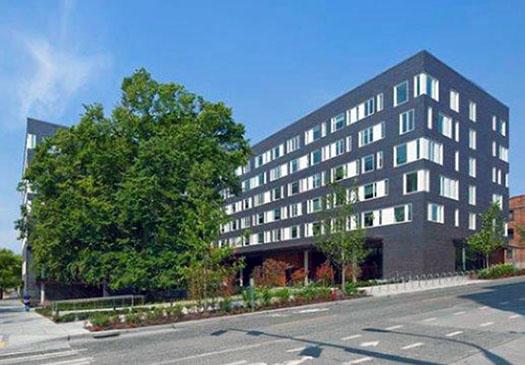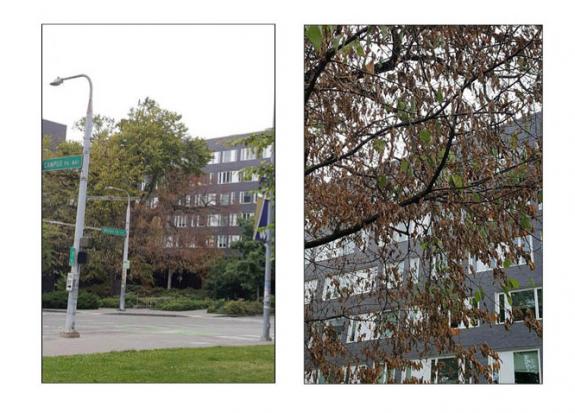Elm Hall loses its namesake

Elm Hall, an L-shaped dormitory, was constructed in 2012 and designed around a majestic American elm tree on the University of Washington’s west campus. The 65-foot tree, nestled in the crook of the dorm, was the area's crowning glory.
But about two years ago the elm tree began showing signs of disease: the prolific and dreaded Dutch elm disease, which has claimed the lives of other elms on campus, throughout the Pacific Northwest and across the United States, became evident.
After a positive test for DED two years ago, arborists from the Washington Park Arboretum climbed the tree multiple times to remove sections of the tree showing signs of DED.
UW Grounds sent samples to the Master Gardeners at Washington State University Diagnostic Lab for testing. Another positive test the following year prompted further pruning. In Washington state, DED is primarily spread through the feeding and breeding activities of bark beetles.
Despite repeated inoculations of fungicide and trimming of affected branches to prevent it from further disease, the tree has since succumbed to DED and it will be removed Aug. 12. Seattle Tree Care, a contractor specializing in tree removal, will be felling the elm using a crane and specially-trained arborists.
American elms are especially susceptible to DED, says Nolan Rundquist, Seattle city arborist.
“While there are some newer cultivars that are hardier, once the disease gets into the roots of a tree, it’s fatal,” he said.
Sara Shores, UW arborist says, “One-third of the tree turned brown within two weeks and there are signs throughout the canopy, which, by now, are further along.”
The courtyard at Elm Hall will be cordoned off on Aug. 12, as will some parking spaces surrounding the area.
Generally untreatable and fatal, the best practice course of action is to fell the tree before its branches become unstable or weaken in the event that they pose a danger.
“We’re losing a great asset of the University,” adds Howard Nakase, Manager, UW Facilities Maintenance and Construction.
Spores and toxins generated at the feeding sites invade the tree’s vascular system, killing the tree, as evidenced by wilting, browning of leaves and branches. Some trees die suddenly, within several weeks, while others, like the Elm Hall tree, are inoculated and the diseased sections pruned to survive. But once the root system is invaded by the fungus, the tree is doomed.
Logs from this tree will be salvaged, milled and dried in our own facilities and used as furniture for campus projects, as part of the Salvage Wood program.
Future plantings of this site are still to be determined. The lush landscape beneath the elm has mostly been protected from direct sunlight and has thrived in that environment. Once the tree is removed, the UW intends to assess how the varieties of plants will adapt to the new conditions before determining next steps relative to replanting.
Kristine Kenney, the UW’s architect says, “We’ve been given an opportunity to rethink how this open space will serve the west campus and particularly the students who live in Elm Hall and the adjacent residence halls. Prior to making any changes, we’ll assemble a team to identify and consider alternatives, ultimately providing a preferred option for implementation.”







